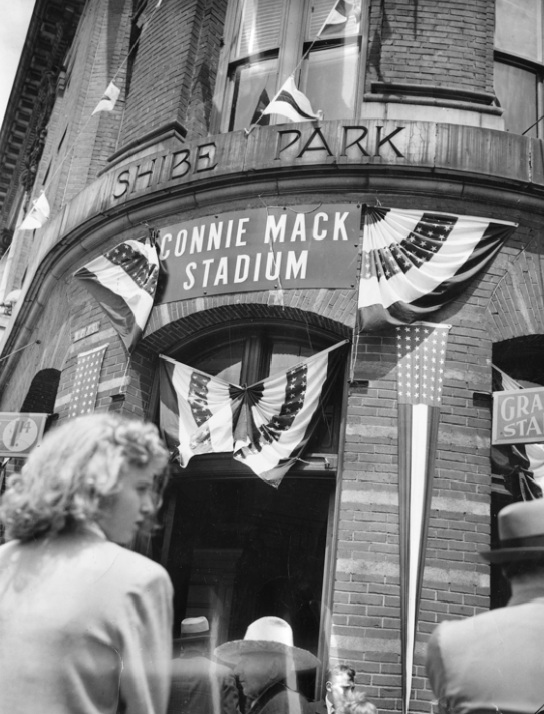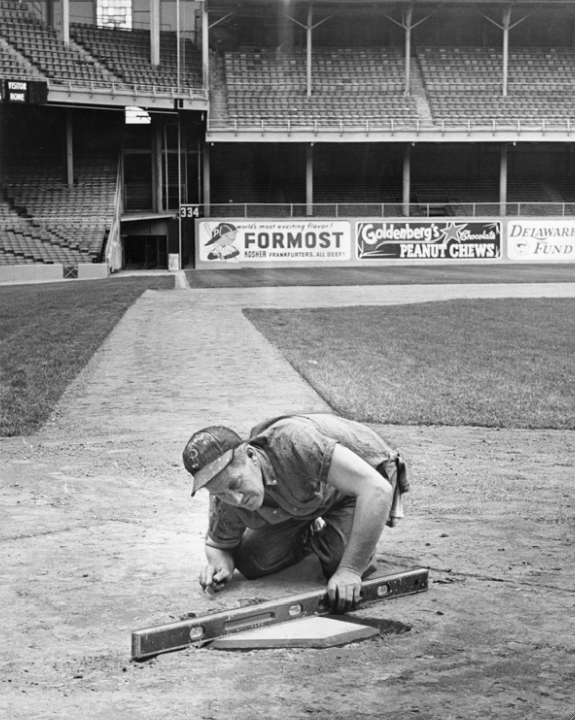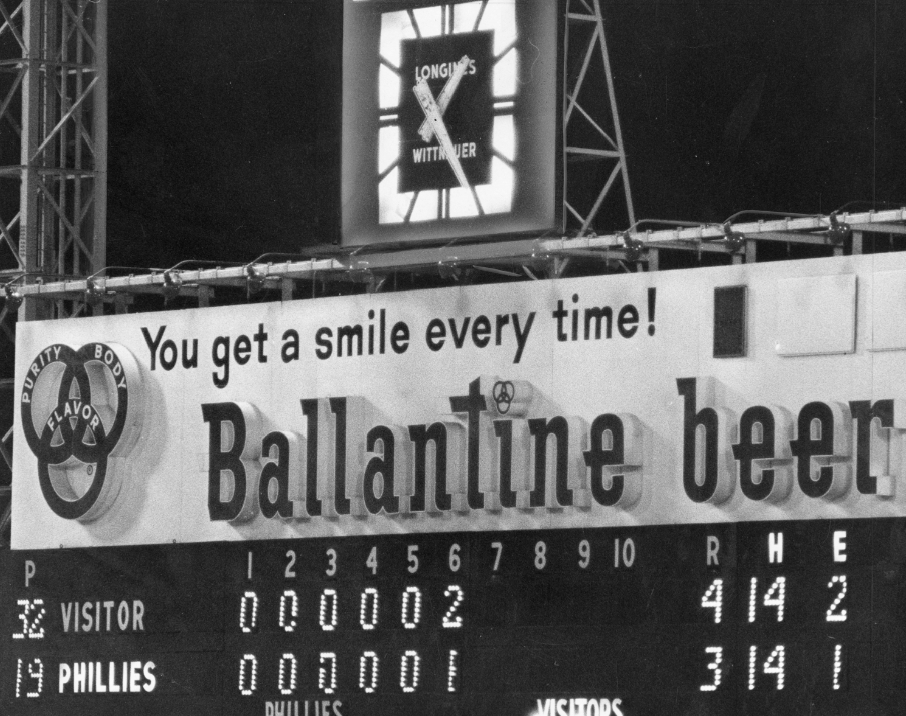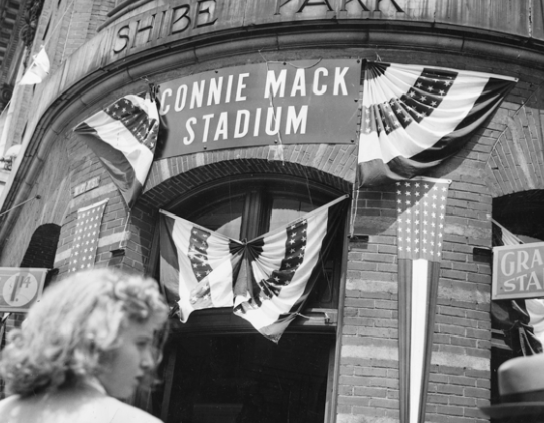Shibe Park/Connie Mack Stadium (Philadelphia)
This article was written by James Lincoln Ray
 Shibe Park, later known as Connie Mack Stadium, goes back to the Philadelphia Athletics, its original occupant, and their owner Benjamin Franklin Shibe. When Shibe in 1901 took charge of the new team, one of eight clubs in the brand-new American League, he could not have foreseen that the Athletics would become so popular so quickly.
Shibe Park, later known as Connie Mack Stadium, goes back to the Philadelphia Athletics, its original occupant, and their owner Benjamin Franklin Shibe. When Shibe in 1901 took charge of the new team, one of eight clubs in the brand-new American League, he could not have foreseen that the Athletics would become so popular so quickly.
Philadelphia already had a major-league team, the National League’s Phillies, who remain the nation’s oldest continuous same-name, same-city sports franchise. Founded in 1883, the Phillies certainly weren’t breaking any attendance records. However, the American League Athletics caught on quickly with Philadelphia fans. In just its second season the team won the American League pennant. The Phillies, by comparison, didn’t win their first pennant until 1915, and their second until 1950 — one of the longest droughts in professional sports. The 1901 A’s attracted more than 206,000 fans to their 9,500-seat home field, Columbia Park, at 29th Street and Columbia Avenue in the North Philadelphia neighborhood known as Brewerytown. Theirs was the highest attendance in the American League, and nearly four times that of the Phillies who played in the Philadelphia Baseball Grounds, known after 1913 as the Baker Bowl.
When the Athletics won their second pennant, in 1905, attendance had grown to more than 550,000. By 1907 it had exploded to 625,000. The team often had to barricade the gates and turn away thousands. Ben Shibe thought that if he built a new park with greater seating capacity, Philadelphia fans would fill the place up.
Shibe found the ideal location for his planned stadium, on Lehigh Avenue between 20th and 21st Streets, just five blocks west of the Phillies’ home, soon-to-be called the Baker Bowl. He liked the site because the land was cheap and it was easily accessible by public transportation. Trolley cars ran east-west along Lehigh Avenue, and north-south along nearby Broad (14th) Street, aptly named because it was by far the widest street in the city, as well as the longest straight street in the United States, and both the Pennsylvania and Reading Railroads had stations close by. The land was cheap because the Philadelphia Hospital for Contagious Diseases, called the “Smallpox Hospital,” was on Lehigh Avenue a block west of Shibe’s site. Shibe used inside information that the hospital was about to be closed down and acted quickly to buy up the entire block, totaling 5.75 acres, for $67,500. He used associates to purchase many small parcels of land in order not to arouse suspicion of his intentions that might lead some owner to hold out for an exorbitant amount.
Shibe wanted more than a stadium. He wanted an edifice of the latest technology, and hired a remarkable company, William Steele and Sons, to construct it. Steele had built some of the city’s most important structures, including the highly acclaimed Witherspoon Building, the city’s first steel and concrete skyscraper, in 1895-97. The firm also designed and built the first cement-mixer truck, which revolutionized the industry. Steele broke ground on Shibe Park in April 1908 and completed the project in less than a year. Five hundred tons of steel and several thousand cubic yards of reinforced concrete were used in the construction.
The original stadium layout had a double-decked grandstand that ran from first base, wrapped around home plate, and continued down the line to third base. A grandstand roof protected fans from the elements, and metal folding chairs replaced common bleacher seats on both levels. The price of admission for lower-level seats was $1, and for upper deck seats was 50 cents.
An additional 13,000 pavilion bleacher seats extended along the foul lines from first and third base to the foul poles. Shibe priced these seats at 25 cents because, as the Evening Telegraph reported, those “who live by the sweat of their brow should have as good a chance of seeing the game as the man who never rolled up his sleeves to earn a dollar.”1 Pleased with the egalitarian design, the Telegraph proclaimed that Shibe had created a stadium “for the masses as well as the classes.”2
In addition to the 23,000 seats, there were two standing-room sections, one in the outfield grass and the other in the wide aisles behind the pavilion bleachers. They could accommodate 17,000 more patrons.
The rectangular shape of the city block resulted in imbalanced dimensions for the field. The block was 40 feet shorter east-west than north-south. With home plate located in the southwest corner of the block, the right-field foul pole was 340 feet and the left-field pole 378 feet from home plate. Center field was enormous. At its deepest, the two perpendicular outfield walls met and formed a right angle 515 feet from home plate.
The exterior of the stadium was more French palace than ballpark. Outside the grandstand, an ornate brick façade had huge arched windows separated by Ionic pilasters, decorative friezes with baseball motifs, and gabled dormer windows on the upper deck’s copper-trimmed green-slate mansard roof. Figurative sculptures in terra cotta of Shibe and co-owner/manager Connie Mack peered out over the main entrances. Other entrances were decorated with the letter “A” carved in Old English script. Above the 21st Street entrance was one of the team’s stores. There was a restaurant for patrons on the ground level that faced both Lehigh and 21st Streets.
The iconic feature of the exterior was the domed tower at the corner of 21st and Lehigh. It contained offices for Shibe’s sons, Jack and Tom, who managed the team’s business operations. A domed cupola topped off the tower and housed Connie Mack’s “Oval Office.”
Upon completion, Shibe Park received rave reviews. “A palace for fans, the most beautiful and capacious baseball structure in the world,” said one Philadelphia newspaper.3 “Shibe Park is the greatest place of its character in the world,” said another.4 Mayor John E. Reyburn called the new facility a “pride to the city.” When he first saw the park, pioneer player George Wright said: “It is the most remarkable sight I have ever witnessed.”5
Monday, April 12, 1909, was Opening Day. By 9 A.M. the ticket line wrapped around the entire city block as baseball fans eagerly waited to see their team in its new baseball palace. As the crowd inevitably became impatient and rowdy, nervous ushers closed the gates to the entrances, turning the fans outside into a howling mob of thousands pressed against the locked barricades.6
Eventually, the weight and pressure of the mass of humanity forced one of the gates open and hundreds poured in without paying. About 7,000 rooters watched the game from the outfield, standing seven-deep and held back by a rope stretched across the entire expanse of the outfield. Another 6,000 fans looked in from rooftops around the block. “It seemed as if all of Philadelphia was there,” wrote the Public Ledger. Mayor Reyburn threw out the first ball a few minutes before the 3:00 P.M. start.
Future Hall of Famer Eddie Plank pitched a wonderful game as the A’s defeated the Boston Red Sox, 8-1. The Philadelphia Evening Bulletin reported, “It was a great day for Philadelphia in the baseball world, it was a great day for the fans, a most profitable one for the owners of Shibe Park, and a grand start for the Athletics. The attendance will probably go on the record as the largest in the history of baseball.”7 Plank’s catcher was 38-year-old backup Doc Powers, who was a physician and very popular around the league. He became ill in the seventh inning but finished the game. He died of complications from peritonitis two weeks later.
The Athletics enjoyed immediate success in their new home. Although they finished in second place in 1909, they won the American League pennant the next season, and went on to hammer the Chicago Cubs in the World Series in five games. The team repeated as world champions in 1911 and then again in 1913, each time beating the New York Giants.
The A’s performance encouraged Shibe to expand the park. He added a new unroofed bleacher section across left field, and also added roof structures to cover the open pavilions down the first-base and third-base lines.
But the record crowds Shibe and Connie Mack hoped for didn’t come. Despite the expanded seating, and another pennant-winning team, attendance dropped sharply in 1914 to 346,000, from a high of 674,915 in 1909 Besides the lowered revenues, the Athletics faced increasing competition for players from the upstart Federal League, which began play in 1914 and induced American and National League stars to jump to the new league. Among them, pitchers Chief Bender and Eddie Plank signed with Federal League teams in December 1914.
Connie Mack decided that it would be better to sell his remaining stars for much-needed cash rather than risk losing them for nothing to the new league. Among those disposed of by Mack were future Hall of Famers Eddie Collins, Frank “Home Run” Baker, and Herb Pennock. By the middle of the 1915 season, the team that later became known as Connie Mack’s First Dynasty had been completely dismantled.
The talent drain led to seven straight last-place finishes and years of anemic attendance figures. Between 1915 and 1921 attendance averaged about 226,000 fans a year, less than a third of what the team had drawn during its heady days. Mack slowly rebuilt his team with new talent and attendance increased. This encouraged Shibe’s sons Jack and Tom, who shared control with Mack after their father’s death in 1922, to upgrade the park again. This time they replaced the open left-field bleachers with a double-decked roofed terrace, installed a 750-seat mezzanine area, raised the original grandstand roof, and installed a press box and 3,500 more seats beneath it.

By 1929 the A’s were once again on top of the baseball world. Behind the feats of future Hall of Famers Jimmie Foxx, Lefty Grove, Mickey Cochrane, and Al Simmons, the A’s ran away with the American League, finishing 104-46, a full 18 games ahead of the Yankees. They crushed the Chicago Cubs in the World Series. The success of the 1929 team led to banner year at Shibe Park: 839,176 passed through the gates, about 30,000 fewer than the record attendance in 1925. When the Athletics repeated as World Series winners in 1930, and won a third straight pennant in 1931, writers began referring to the team as Connie Mack’s Second Dynasty. The future for the team, its fans, and Shibe Park looked as promising and full of hope as a clear spring morning.
By 1932 the full effects of the Great Depression hit Philadelphia. The team drew less than 300,000 fans three times within four seasons (1933-1936), and hitting a low of 233,173 in 1935. Facing financial pressures and dim income prospects, Mack once again sold off his star players, and once again the team fell into the American League cellar. Fans stopped coming to the park. A terrible team and a worse economy were not a good recipe for drawing the working class to the ballpark. The Depression also led to the end of a great Shibe Park tradition that forever damaged the relationship between the A’s and their neighborhood fans.
From the time Shibe Park opened in 1909 through the end of Mack’s Second Dynasty, homeowners on 20th Street had a clear view of the ballpark’s playing field. They could watch games from their top-floor windows and their rooftops. Some said that the views from 20th Street compared favorably with many of the seats inside the park. Enterprising homeowners constructed bleachers on their roofs and sold tickets. During the 1929 World Series, almost 3,000 people watched from the makeshift bleachers. Two more World Series further lined the pockets of these homeowners.
As long as the Athletics were drawing big crowds, Mack and the Shibes tolerated the situation. But when attendance continued to decline after the selloff of the Second Dynasty, and when the team learned that strapped homeowners who could no longer fill their rooftop bleachers were pilfering customers from Shibe Park’s ticket line, Jack Shibe decided that enough was enough. In the winter of 1934-1935, the team built a 22-foot-high corrugated metal extension wall on top of the outfield wall. The extension made the right field wall 50 feet high and blocked the view of the field from the 20th Street rooftops.8 Fans labeled the wall the spite fence or Connie Mack’s Spite Wall, even though Jack Shibe had spearheaded the project.
The wall didn’t just spite fans, it also infuriated some players who figured they were going to lose home runs. Outfielders also despised the hulking structure because its rippled corrugated facing caused baseballs to carom unpredictably.
Angry residents sued to have the fence taken down. Mack hired a tough young attorney named Richardson Dilworth, who won the case and the Spite Wall stayed. Dilworth later became a two-term mayor of Philadelphia.
In the middle of the 1938 season, the Phillies abandoned crumbling Baker Bowl and became tenants of the Athletics at Shibe Park. Despite resistance from neighbors, Mack installed eight 146-foot light towers. The first night game in the American League was played at Shibe Park on May 16, 1939. The A’s lost to the Cleveland Indians, 8-3.
After World War II, Mack tried to expand the seating capacity again, this time to 50,000. There was a problem with the design, however; the rear wall would protrude past the right-field fence, hanging 15 feet above the sidewalk of North 20th Street and forming a covered arcade walkway. The proposal galvanized the 20th Street neighbors against Mack, and this time his legal team lost.
Although the A’s would never field a legitimate contender after the 1932 dismantling (though they were in a crowded race in 1948), the ballpark’s other tenant, the Phillies, had been stockpiling young talent after World War II and had a remarkable season in 1950. They dramatically defeated the Brooklyn Dodgers on the last day of the season and captured the National League pennant, the last in the history of the ballpark. They were swept in the World Series by the Yankees.
After the 1950 season, the 87-year-old Mack retired after managing the Athletics for 50 years, the longest managerial tenure in baseball history. In a last effort to revitalize the team, Mack’s children changed the name of Shibe Park to Connie Mack Stadium before the 1953 season. It didn’t help at the box office. In 1954 the A’s drew just over 300,000 fans, less than one-half the Phillies’ attendance and not nearly enough to support a two-family business (the Macks and the Shibes). It was clear to all that Philadelphia would no longer support two baseball teams. Heavily in debt to the banks, in August 1954 the owners sold the franchise to Chicago businessman Arnold Johnson for $3.375 million. Johnson moved the team to Kansas City for the 1955 season.

Phillies owner Bob Carpenter purchased Connie Mack Stadium for $1.675 million and made immediate changes. When the ballpark opened for the 1955 season, large billboards covered the outfield walls advertising Goldenberg’s Peanut Chews, Plachter Cadillac, Alpo dog food, and Coca-Cola. Carpenter installed a new straight-across fence that covered the awkward square corner in center field and lessened the distance to center field to 447 feet. In 1956 he purchased a 50-foot-high outfield scoreboard similar to the one in Yankee Stadium. It was topped by a ten-foot-high Ballantine Beer sign, and was capped with a distinctive Longines clock.
After Connie Mack died in February 1956, sculptor Harry Rosin created a statue of “Mr. Baseball.” It was unveiled on April 16, 1957, across Lehigh Avenue in Reyburn Park (rededicated as Connie Mack Plaza) as part of the Opening Day ceremonies.
The final game at Connie Mack Stadium was played on October 1, 1970, with the Phillies defeating the Montreal Expos, 2-1, in ten innings. Souvenir hunters began dismantling the stadium while the game was still in progress. They pulled up chairs, signs, gates, and the sod from the field. A postgame ceremony was canceled because of the mayhem. Over a headline that said, “Wrecking Crew of 31,822 Breaks Up the Old Ball Park,” the Philadelphia Inquirer wrote, “Fans ripped up their seats and ransacked the dugouts. They tore off railing[s] and billboards. A gigantic old rain tarp was torn to shreds and both the infield and outfield were ruined.”9 A shameful end to a once-beautiful ballpark.
Over its 62 seasons, Shibe Park drew more than 47 million fans. The 1964 Phillies drew the highest single-season attendance, 1,425,891. The Athletics’ best-attended season was 1948, when they last were in contention for a pennant, and drew 945,076 fans. The A’s and the Phillies won a total of eight pennants in the ballpark. The Athletics played in seven World Series during their tenure at the stadium, and clinched three of their five championships at Shibe Park.
Other great baseball moments at Shibe Park include the 1943 and 1952 All-Star Games; the first American League night game, in 1939; four no-hitters by A’s pitchers; and three historic performances by opposing players.
The first of those occurred on June 3, 1932, when the Yankees’ Lou Gehrig hit four home runs. He narrowly missed a fifth homer when Al Simmons made a great running catch at the wall in center field. The second historic feat came on September 28, 1941, the last day of the season. The Red Sox were in town for a season-ending doubleheader. The matchup meant nothing in the standings, but it did mean a lot in the record books. Ted Williams entered the day with a .3995 batting average, which would have officially been rounded up to .400 had he decided not to play. But Williams played, went 6-for-8 in the doubleheader, and finished the season at .406.
The third outstanding performance involved the Phillies. Sandy Koufax pitched a no-hitter against them on June 4, 1964 (Los Angeles Dodgers 3, Phillies, 0). Koufax faced the minimum 27 batters and struck out 12. Only a walk to Richie Allen on a full count in the fourth inning kept it from being a perfect game. Allen was thrown out trying to steal second base.
Events at Shibe Park/Connie Mack Stadium were not limited to Athletics and Phillies games. The park hosted its first Negro League game in 1919, and served as a neutral site for the 1945 Negro League series in which the Cleveland Buckeyes defeated the Homestead Grays. The Negro League Philadelphia Stars played home games at Shibe Park in the 1940s, and often drew crowds of more than 10,000.
The National Football League’s Philadelphia Eagles moved to Shibe Park in 1940 and played their home games there through the 1957 season. During that tenure, the Eagles won the 1948 and 1949 NFL titles. The 1948 title game was played in a blizzard. Several championship boxing matches were also held at the park, the most famous of which was between Benny Leonard and Johnny Kilbane in 1917.
Events at Shibe were not always sports-related. In 1940 Republican presidential candidate Wendell Willkie came to Shibe for a speech and political rally. Four years later, Franklin Delano Roosevelt made one of his few 1944 public appearances at 21st and Lehigh. In 1948 Progressive Party candidate Henry A. Wallace made his acceptance speech there. The Ringling Brothers Circus set up shop at Shibe in 1955, and evangelist Billy Graham had many successful events there. A rodeo came to the park in 1962, but the animals destroyed the turf and weren’t invited back.
Less than a year after the final baseball game, two brothers sneaked into the park and started a fire that grew into a five-alarm blaze. The fire burned through most of the original upper deck, collapsing the roof. The intense heat twisted and exposed the steel beams and left them grasping out finger-like. The ballpark remained in this condition for four years until October 1975, when a judge issued an order that it be demolished. The famous corner tower and its domed cupola was the last section of the ballpark demolished, on July 13, 1976.
In 1991 Deliverance Evangelistic Church built a church on the site. A historical marker for the ballpark was erected by the Philadelphia Historical Commission on November 9, 1997.
Photo credits
National Baseball Hall of Fame Library
Sources
Fitzpatrick, Frank. “Bad Playoff Weather Dogged the Eagles of Old,” Philadelphia Inquirer, January 19, 2003.
Karsch, Carl G. “Five Generations of Builders,” www.ushistory.org/carpentershall.
Kuklick, Bruce. To Everything a Season: Shibe Park and Urban Philadelphia (Princeton, New Jersey: Princeton University Press, 1991).
Macht, Norman L., Connie Mack and the Early Years of Baseball (Lincoln: University of Nebraska Press, 2007).
Westcott, Rich. Philadelphia’s Old Ballparks (Philadelphia: Temple University Press, 1996).
“30,000 in New Shibe Park,” New York Times, April 12, 1909.
Philadelphia Public Ledger, April 12, 1909.
Philadelphia Evening Bulletin, April 12, 1909.
Philadelphia Inquirer, April 13, 1909.
Baseball-Reference.com.
BaseballAlmanac.com.
Retrosheet.org.
www.philadelphiaathletics.org.
Notes
1 Rich Westcott, Philadelphia’s Old Ballparks (Philadelphia: Temple University Press, 1996), 105.
2 Westcott, 105.
3 Philadelphia Public Ledger, April 12, 1909.
4 Westcott, 109.
5 Westcott, 109.
6 Philadelphia Public Ledger, April 13, 1909.
7 The official paid attendance was 30,162. An additional 5,000 fans either sneaked in or had free passes to attend. Several thousand more sat on the rooftops of the homes on 20th Street, and another 30,000 crowded the streets outside the stadium.
8 Ballparksofbaseball.com, https://www.ballparksofbaseball.com/ballparks/shibe-park/
9 Philadelphia Inquirer, October 2, 1970, 1.


